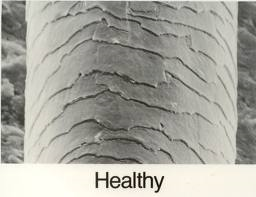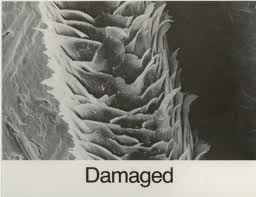
Hair has two functions – one is how it protects us and the other is how it makes us look and feel.
Hair is a coat for our scalp providing a protective barrier for insulation against heat and coldness. It also protects us from UV light and is a barrier between our scalp and trauma.
How we feel about hair can be quite complex. Hair is highly valued across all cultures and holds historical significance in fables and the Bible. Hair style expresses our personalities while hair loss can signify stress and health related issues.
Globally, Hair Care is the second largest personal care category, second only to facial care. Shampoos and conditioners represent almost two thirds of the hair care market followed by hair dyes, styling products and hair treatments.
Desktop research identifies six important hair needs worldwide:
- Dry & Damaged Hair
- Dandruff
- Hair Loss
- Coloured Hair
- Shine (normal hair)
- Volume
Looking at hair types we have identified four types of hair:
Normal Hair
Healthy, normal hair is unaffected by age, gender, colour or thickness. It has a natural shine, feels smooth and is easy to comb. It has no split ends, is balanced, displays no dandruff and the scalp is normal.
Hair needs
Shampoos should be mild to keep the cuticle intact and conditioner can be used on the tips of long hair.
Stressed Hair
Common causes of dry damaged hair:
Genetic predisposition or other underlying factors:
- Age, puberty, menstrual cycle, pregnancy or menopause can increase the chance of developing dry hair. As can illness, the side effects of medication and poor diet.
Environmental Factors:
- Humidity, sun, heat
Chemical ‘stresses’:
- Chemicals found in hair products
- Damage through various treatments such as colouring, bleaching, permanent straightening and curling
Mechanical ‘stresses’:
- Hair Grooming tools such as plastic combs and brushes
- Hairdryers and straighteners
- The appearance of stressed hair is dry and damaged where the hair loses its sheen and becomes dull, brittle and prone to break.
Hair needs
Shampoos should be mild to protect the cuticle against further damage. Conditioner should be used to restore and replenish the damaged protective film of the hair. Products should improve strength and moisture properties.
Dandruff
Dandruff is characterised by visible, excessive build-up of flakes on head hair.
Dandruff can be due to increased activity of sebaceous glands causing greasy dandruff or increased hornification or flaking, which is dry dandruff. A healthy scalp casts off horny cells as small flakes which are nearly invisible but go unnoticed. A scalp with dandruff has horny cells coming together in larger pieces (at least 500 cells) which make dandruff visible.
Factors for development of dandruff:
- Tendency towards excessive sebum production and increased flaking.
- Excessive irritation of the scalp often caused by the residue of the hair care products and central heating.
- Bacteria which colonise when hair follicle is full with sebum causing excessive oil to spread over the scalp.
- Chronic irritation which leads to constant scratching can introduce new germs to the scalp and it becomes a vicious circle.
- Dandruff can also be an accompanying symptom of some skin diseases such as allergy and psoriasis.
There are two different types of dandruff:
Greasy dandruff: Large, often yellowish dandruff which ‘sticks’ firmly to the scalp, caused by excessive sebum production which causes itching.
Dry dandruff: Small, white dandruff loosely scattered in the hair and falls onto the shoulders, caused by irritated dry and sensitive skin. The irritation leads to an over production of the horny layer resulting in dry loose scales.
Hair needs
Shampoos should be mild, to reduce irritation and restore balance to the scalp. Depending on the cause of the dandruff the product should contain special ingredients such as anti-fungal substances.
Hair Loss (alopecia)
Alopecia is defined by the loss of more than 150 hairs per day and/or development of hairless parts. It can be congenital or acquired, irreversible or reversible. Extensive physical hair damage can also cause hair loss such as incorrect use of hair colours, waves or bleachers; teasing; pressure from wearing helmets or tension from tight hair styles.
Different types of Alopecia:
Alopecia diffusa is where excessive hair loss on the whole scalp occurs. Rather than skin or scalp it can be related to stress, infections, diet-related deficiencies of minerals, vitamins, etc. or medications or intoxications (heavy metals for example). The hair growth in the follicle is disrupted, but the follicle is still fully functioning and often can be reversed.
Alopecia androgenetica congenital, irreversible hair loss (often family history). This affects about 50% of men beginning in their adolescence as a receding hair line or back part of vertex. Can affect 10% of women on vertex (mostly after menopause) hormone dependant, mostly congenital.
Alopecia areata can spontaneously appear on the scalp and on other body parts such as beard and eyelashes. The reasons are often unclear as to why this happens.
Hair needs
Shampoos should be mild with less scalp irritation potential. Products should stimulate the hair roots with nutrients to strength the hair.
Our hair makes us who we are, no matter how much or how little we have. Our genetics, our environment, our age and our lifestyle can all influence what we do have. Our job is to look after our hair that looks after us.
Weleda New Zealand
In line with Weleda’s holistic approach, Weleda believes there is much more to haircare than simply washing the hair. Particular importance should be placed on two aspects: a mild but thoroughly cleansing effect and the promotion of a healthy scalp. After all, a healthy scalp is the prerequisite for naturally beautiful hair.
For those converting to natural hair care, Weleda suggests that the Oat Replenishing Shampoo in combination with the Oat Replenishing Conditioner is ideal. The mild surfactants in Weleda hair care products ensure excellent cleansing despite producing little foam and are tailored to the individual needs of the scalp and hair.
The new Weleda Hair Care range is 100% NATRUE certified, having passed stringent criteria to guarantee the use of natural and organic ingredients and processes. Millet Nourishing Shampoo gently cleanses and maintains natural shine and is suitable for normal and oily hair. Oat Replenishing Shampoo smoothes the surface of dry and damaged hair and reduces breakage. Oat Replenishing Conditioner improves elasticity, suppleness and shine to dry and damaged hair. Wheat Balancing Shampoo reduces dandruff and promotes a healthy scalp. Revitalising Hair Tonic strengthens hair and invigorates the scalp.
All of these products are available for secure order from our online shop.
We'd Love Your Feedback
What hair type do you have and how do you care for it?
Do you use natural hair care products?
What is your favourite hair care product?



